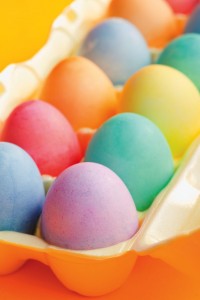NEW YORK — Easter eggs are a centerpiece of many family traditions come Easter Sunday. Easter eggs symbolize fertility and rebirth to some, but many people associate Easter eggs with youngsters scouring the yard in search of treasure.
Here are some of the more common myths about Easter eggs that have made the rounds.
Myth No. 1: Easter eggs are safe to eat after your egg hunt is over.
Fact: Hard-boiled eggs generally remain safe to eat at room temperature for about two hours. If the temperature outside or indoors is very warm, the eggs should be eaten within one hour. People risk food-borne illnesses if they consume Easter eggs that have been left out for several hours or overnight.
It is better to dispose of colored eggs after the annual egg hunt or at least keep hard-boiled eggs refrigerated until the hunt begins.
And here’s a great Pickled Egg recipe, if you want a twist on the usual.
Myth No. 2: It is unsafe to eat all dyed Easter eggs.
Fact: Whether dyed eggs are safe or not depends on the type of dye used. Many kits use vegetable-based dyes that are food-safe. These same pigments are used in traditional food coloring.
Even if the dye has penetrated beneath the shell, it should still be safe for consumption.
Kits for blown-out eggs may use dyes that are not food-safe. Also, people who are allergic to certain food dyes might want to avoid eating dyed eggs.
Myth No. 3: Pastel-colored eggs have long-rooted religious significance.
Fact: An Easter egg hunt is a tradition that originated with pagan spring festivals. But like many pagan practices, Easter egg hunting was eventually adopted by Christians and assigned religious significance.
In the Orthodox and Eastern Catholic Churches, Easter eggs are dyed red to represent the blood of Christ shed on the cross, and, for many, the hard shell of the egg symbolizes the sealed Tomb of Christ.
In A.D. 1610 under Pope Paul V, the Christian Church officially adopted the Easter egg custom that the eggs symbolize the resurrection.
Myth No. 4: An Easter egg roll is an American tradition.
Fact: In Germany, England and other countries, children traditionally rolled eggs down hillsides at Easter. This practice may have initially symbolized the rolling away of the rock from Jesus Christ’s tomb before his resurrection. When European immigrants arrived in North America, they brought these Easter egg traditions with them.
One of the more popular Easter egg rolls of modern day takes place on the White House lawn, where children push an egg through the grass with a long-handled spoon. Some say this tradition was established by Dolly Madison in 1814.
Myth No. 5: A raw egg will stand on end during the spring equinox.
Fact: It is believed that because the sun is equidistant from the south and north poles on the spring equinox, special gravitational forces apply on this day. These forces should make it possible to balance an egg on its end only on this day. However, eggs can be balanced at other times of the year. Perhaps instead of hiding eggs for Easter, families may choose to hold egg-balancing competitions.












